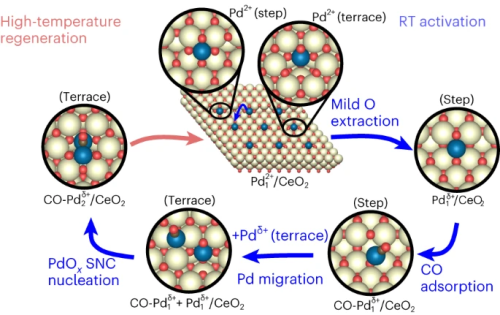Precious Metals
New single-atom catalyst removes methane from engine exhaust at lower temperatures, while remaining stable at high temperatures
A new study by researchers from Washington State University and SLAC National Accelerator Laboratory has found that a catalyst using a single or just a…

A new study by researchers from Washington State University and SLAC National Accelerator Laboratory has found that a catalyst using a single or just a few palladium atoms removed 90% of unburned methane from natural gas engine exhaust at low temperatures. The work is published in the journal Nature Catalysis.
While more research needs to be done, the advance in single-atom catalysis has the potential to lower exhaust emissions of methane, one of the worst greenhouse gases that traps heat at about 25 times the rate of carbon dioxide.
The study showed that the single-atom palladium catalyst on a cerium oxide support was able to remove methane from engine exhaust at lower temperatures—less than 350 ˚C—while maintaining reaction stability at higher temperatures.
It’s almost a self-modulating process which miraculously overcomes the challenges that people have been fighting—low temperature inactivity and high temperature instability.
—Yong Wang, Regents Professor in WSU’s Gene and Linda Voiland School of Chemical Engineering and Bioengineering and a corresponding author on the paper
Natural gas engines are used in about 30 million to 40 million vehicles worldwide and are popular in Europe and Asia. The gas industry also uses them to run compressors that pump natural gas to people’s homes. They are generally considered cleaner than gasoline or diesel engines, creating less carbon and particulate pollution.
However, when these natural gas-powered engines start up, they emit unburnt, heat-trapping methane because their catalytic converters don’t work well at low temperatures. The catalysts for methane removal are either inefficient at lower exhaust temperatures or they severely degrade at higher temperatures.
There’s a big drive towards using natural gas, but when you use it for combustion engines, there will always be unburnt natural gas from the exhaust, and you have to find a way to remove that. If not, you cause more severe global warming. If you can remove 90% of the methane from the exhaust and keep the reaction stable, that’s tremendous.
—co-author Frank Abild-Pedersen, a staff scientist at SLAC National Accelerator Laboratory
A single-atom catalyst with the active metals singly dispersed on a support also uses every atom of the expensive and precious metals, Wang added.
In their work, the researchers were able to show that their catalyst made from single palladium atoms efficiently removed methane from engine exhaust, even when the engine was just starting.
They found that trace amounts of carbon monoxide that are always present in engine exhaust played a key role in dynamically forming active sites for the reaction at room temperature. The carbon monoxide helped the single atoms of palladium migrate to form two- or three-atom clusters that efficiently break apart the methane molecules at low temperatures.
Then, as the exhaust temperatures rose, the sub-nanometer-sized clusters re-dispersed to single atoms again so that the catalyst was thermally stable. This reversible process enables the catalyst to work effectively and uses every palladium atom the entire time the engine was running—including when it started cold.
Simulated Pd/CeO2 interfacial evolution in response to reaction conditions. Jiang et al.
We were really able to find a way to keep the supported palladium catalyst stable and highly active and because of the diverse expertise across the team, to understand why this was occurring.
—Christopher Tassone, a staff scientist at SLAC National Accelerator Laboratory and co-author
The researchers are working to further advance the catalyst technology. They would like to better understand why palladium behaves in one way while other precious metals such as platinum act differently.
The research has a way to go before it will be put inside a car, but the researchers are collaborating with industry partners as well as with Pacific Northwest National Laboratory to someday move the work closer to commercialization.
The work was funded by the US Department of Energy’s Office of Basic Energy Sciences.
Resources
-
Jiang, D., Wan, G., Halldin Stenlid, J. et al. (2023) “Dynamic and reversible transformations of subnanometre-sized palladium on ceria for efficient methane removal.” Nat Catal doi: 10.1038/s41929-023-00983-8

Canadian Silver Co. Will See Big Changes in 2024
Source: Michael Ballanger 12/22/2023
Michael Ballanger of GGM Advisory Inc. takes a look at the current state of the market and shares on stock…
EGR options out Urban Berry project in Quebec to Harvest Gold – Richard Mills
2023.12.23
EGR Exploration Ltd. (TSXV: EGR) has moved from owner to shareholder at its Urban Berry project in Quebec, this week announcing it is optioning…
Crypto, Crude, & Crap Stocks Rally As Yield Curve Steepens, Rate-Cut Hopes Soar
Crypto, Crude, & Crap Stocks Rally As Yield Curve Steepens, Rate-Cut Hopes Soar
A weird week of macro data – strong jobless claims but…










